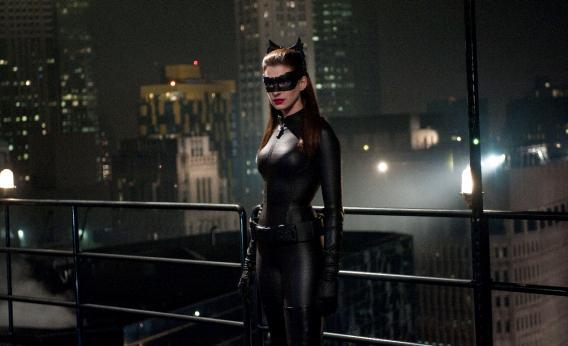The critical reaction to The Dark Knight Rises has been sharply divided between people who see it as a masterful conclusion to a trilogy that redefined superhero movies and those who found it a soulless Rube Goldberg Machine. But in between thundering fight scenes and ponderous monologues, there was a wicked glint of something tremendously fun: Anne Hathaway as the best Catwoman ever to grace the big screen.
Catwoman has, in the past, been a rich well for explorations of female trauma. In one comics origin story, Selina Kyle (Catwoman’s given name) began her life of crime by stealing her jewelry back from the vault of the abusive husband she was in the process of leaving. Frank Miller, looking back to Batman’s noir roots, made Selina a prostitute at the mercy of a violent pimp in his The Dark Knight comics. In Batman Returns, Tim Burton presented her as a mousy office worker pushed out a window by that avatar of bloodless unease, Christopher Walken, on whom she bestowed a murderous, electrified smooch in the movie’s climax. And the unfortunate 2004 Catwoman movie starring Halle Berry climaxed in an actual catfight between Berry’s feline avenger and Sharon Stone’s wicked cosmetics executive.
But in The Dark Knight Rises, Selina isn’t a victim. The movie is an illustration of both the virtue of making a tough female character something other than the casualty of the sorts of violence and misery particular to women, and of abandoning origin stories altogether in superhero movies. Hathaway enters wearing a maid’s uniform and delivering Bruce Wayne’s dinner on a silver tray, but needs no precipitating incident to begin meddling with his safe. They share a dance at a charity function that Wayne has denounced as a showpiece for a “society hag,” and Selina is attending on the arm of a philandering industrialist whose wife has decamped to Ibiza, leaving her jewels behind. Mid-twirl, she refers to the distorting effects of doing what it takes to survive rather than pursuing a career and a life based on choice and preference, but the movie never explains what circumstances she’s risen from and what events in her criminal record she’d prefer to erase.
Declining to dwell on backstory frees Selina to act in pursuit of and to discuss actual ideas. Her visit to Wayne Manor is part of a bargain she’s struck with Daggett, a sinister corporate smoothie in league with Bane, a rather less polished but significantly more hulking terrorist. They enticed her with a promise of technology that would eliminate not just her rap sheet, but all record of her, in every international database in the world. She’s motivated not just by self-interest, but a more visceral disgust at a world where people have no chance to redefine themselves, whether they’re teenagers who’ve posted something dumb on social media, depressive billionaires, or talented criminals trapped by past misdeeds in cramped apartments in rotting neighborhoods.
It’s not only surveillance technology—a concern touched on to rather more dramatic fashion in the conclusion of 2008’s The Dark Knight—that Selina sees as a dangerous restriction on the ability of Gotham’s citizens to remake themselves. She is the first character in the movie to speak eloquently on class and inequality, telling Bruce during their spin on the dance floor, “You and your friends better batten down the hatches. There’s a storm coming … You’re going to wonder how you could live so large and leave so little for the rest of us.” It’s a much more compelling stiletto of a warning than Bane’s cliched calls for revolution. Where Bane is both literally and figuratively a strawman, his promised revolution turning quickly into an arbitrary, stupid reign of terror, Selina’s concern for Gotham remains real. Batman punches individual criminals in the face before retreating to the restorative safety of Wayne Manor. Selina fends off evildoers and helps Gotham street kids survive, casting a protective net over the neighborhood she has no choice but to remain in.
Still, she does retain a lady’s privilege to change her mind, and as a result, to grow, and to refine her ideas and re-evaluate her allegiances. She may start as Han Solo, so skeptical of Bruce Wayne that it wouldn’t have been out of place to hear her snap “I ain’t in this for your counterrevolution.” And she ends as someone who, free of binding financial debts and ties to those who would do her harm, can bring safety to Gotham and joy to Bruce Wayne—and to the rest of us. Bruce may see protecting Gotham as a way to pay his debt to his parents. Hathaway’s Selina gives him a living reason to love his city, and to return to life.
